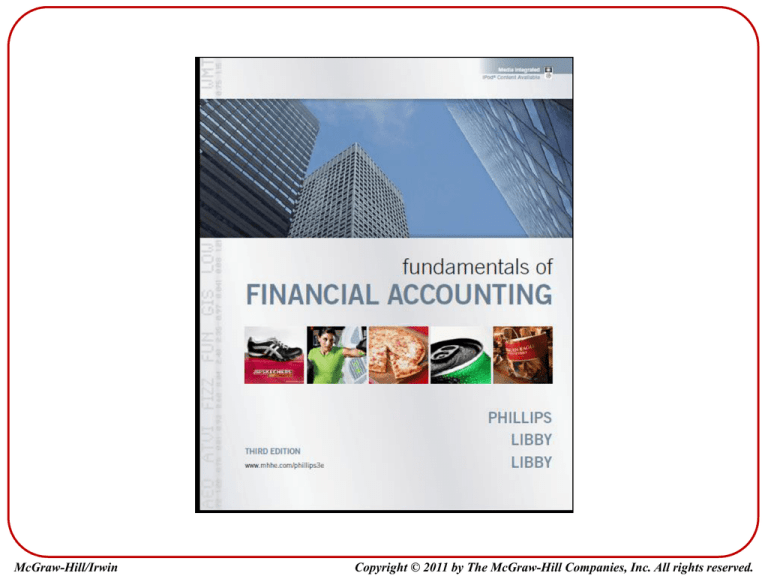
McGraw-Hill/Irwin
Copyright © 2011 by The McGraw-Hill Companies, Inc. All rights reserved.
Chapter 7
Reporting and Interpreting
Inventories and Cost of Goods Sold
PowerPoint Authors:
Susan Coomer Galbreath, Ph.D., CPA
Charles W. Caldwell, D.B.A., CMA
Jon A. Booker, Ph.D., CPA, CIA
Fred Phillips, Ph.D., CA
Types of Inventory
Merchandisers . . .
Buy finished goods.
Sell finished goods.
Merchandise inventory
Manufacturers . . .
Buy raw materials.
Produce and sell
finished goods.
Raw Materials
Work in Process
Finished goods
Completed products
awaiting sale
Materials waiting to
be processed
Partially
complete products
7-3
Balance Sheet and Income
Statement Reporting
7-4
Cost of Goods Sold Equation
BI + P – CGS = EI
American Eagle Outfitters’ beginning inventory was $4,800.
During the period, the company purchased inventory for
$10,200. The cost of goods sold for the period is $9,000.
Compute the ending inventory.
+
=
–
=
7-5
Cost of Goods Sold Calculation
Beginning Inventory
$ 4,800
Purchases
10,200
Cost of Goods Available for Sale
15,000
Cost of Goods sold
9,000
Ending Inventory
$ 6,000
Cost of Goods Sold Equation
Beginning
Inventory
$4,800
+
Purchases
$10,000
Goods Available
for Sale
$15,000
7-6
Ending
Inventory
$6,000
Cost of
Goods Sold
$9,000
(Balance Sheet)
(Income Statement)
Inventory Costing Methods
Consider the following information
May 3
May 5
May 6
May 8
Purchased 1 unit for $70
Purchased 1 more unit for $75
Purchased 1 more unit for $95
Sold 2 units for $125 each
May 6
$95 cost
May 5
$75 cost
May 3
$70 cost
Specific Identification
This method individually identifies and records the cost of
each item sold as part of cost of goods sold. If the items
sold were identified as the ones that cost $70 and $95, the
total cost of those items ($70 + 95 = $165) would be
reported as Cost of Goods Sold. The cost of the remaining
item ($75) would be reported as Inventory on the balance
sheet at the end of the period.
7-7
Inventory Costing Methods
LIFO
May 6
$95 cost
7-8
Sold
May 3
$70 cost
Still there
Sold
May 5
$75 cost
Weighted average
May 6
$95 cost
May 6
$95 cost
May 5
$75 cost
May 5
$75 cost
May 3
$70 cost
May 3
$70 cost
Income Statement
Net Sales
$ 250
Cost of Goods Sold 145
Gross Profit
$ 105
Income Statement
Net Sales
$ 250
Cost of Goods Sold 170
Gross Profit
$ 80
Balance Sheet
Inventory
$ 95
Balance Sheet
Inventory
$ 70
Still there
FIFO
$240 = $80
per unit
3
Income Statement
Net Sales
$ 250
Cost of Goods Sold 160
Gross Profit
$ 90
Sold
Balance Sheet
Inventory
$ 80
Still
there
Financial Statement Effects
Effects of Increasing Costs on the Financial Statements
Inventory (Balance sheet)
Cost of Goods Sold (Income Statement)
FIFO
Higher
Lower
LIFO
Lower
Higher
Effects of Decreasing Costs on the Financial Statements
Inventory (Balance sheet)
Cost of Goods Sold (Income Statement)
7-9
FIFO
Lower
Higher
LIFO
Higher
Lower
Financial Statement Effects
Advantages of Methods
Weighted
Average
First-In,
First-Out
Last-In,
First-Out
Smoothes out
price changes.
Ending inventory
approximates
current
replacement cost.
Better matches
current costs in
cost of goods sold
with revenues.
7-10
Lower of Cost or Market
The value of inventory can fall below its
recorded cost for two reasons:
1. it’s easily replaced by identical goods at a
lower cost, or
2. it’s become outdated or damaged.
When the value of inventory falls below its
recorded cost, the amount recorded for
inventory is written down to its lower
market value. This is known as the lower of
cost or market (LCM) rule.
7-11
Lower of Cost or Market
1,000 items @ $165
Item
Leather coats
Vintage jeans
1
Cost
per
Item
$165
20
Analyze
Assets
Inventory –15,000
2
7-12
Record
Market
Value
per Item
$
150
25
LCM
Total Lower
per
of cost
Total
Item Quantity or Market
cost
Writedown
$ 150
1,000 $ 150,000 $ 165,000 $ 15,000
20
400
8,000
8,000
-
400 items @ $20
1,000 items @ $150
=
Liabilities
+
Stockholders' Equity
Cost of Goods sold (+E) –15,000
Inventory Purchases
American Eagle Outfitters purchases
$10,500 of vintage jeans on credit.
1 Analyze
Assets
Inventory –10,500
2 Record
7-13
=
Liabilities
+
Accounts Payable +10,500
Stockholders' Equity
Transportation Cost
American Eagle pays $400 cash to a trucker who
delivers the $10,500 of vintage jeans to one of its stores.
1 Analyze
Assets
Cash - 400
Inventory + 400
2 Record
7-14
=
Liabilities
+
Stockholders' Equity
Purchase Returns and
Allowances
American Eagle returned some of the vintage jeans to the
supplier and received a $500 reduction in the balance owed.
1
Analyze
Assets
Inventory - 500
2 Record
7-15
=
Liabilities
Accounts Payable - 500
+
Stockholders' Equity
Purchase Discounts
American Eagle’s vintage jeans purchase for $10,500 had
terms of 2/10, n/30. Recall that American Eagle returned
inventory costing $500 and received a $500 reduction in its
Accounts Payable. American Eagle paid within
the discount period.
1
Analyze
Assets
Cash - 9,800
Inventory -200
2 Record
7-16
=
Liabilities
+
Accounts Payable -10,000
Stockholders' Equity
Inventory Turnover Analysis
7-17
End of Chapter 7

